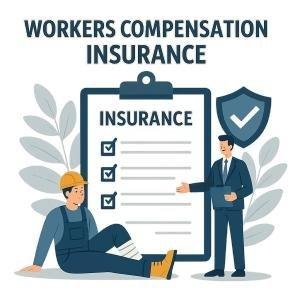
Workers Comp Seminar: What Your Leadership Team Must Know
September 8, 2025
Captive vs. Guaranteed Cost: Which Workers’ Comp Model Fits Georgia Guard Companies?
September 8, 2025In the highly regulated and risk-prone security industry, managing workers’ compensation costs is a critical concern for security guard CEOs aiming to safeguard both their workforce and their bottom line. Effectively tracking key metrics not only ensures compliance and mitigates financial exposure but also drives strategic decision-making to enhance overall operational efficiency. This article explores the essential metrics that every security guard CEO should monitor to maximize the return on investment (ROI) from their workers’ compensation programs, ultimately fostering a safer workplace and stronger business performance.
Table of Contents
- Key Performance Indicators for Monitoring Workers’ Compensation Costs
- Analyzing Injury Frequency and Severity to Optimize Safety Programs
- Strategies for Improving Return-to-Work Rates and Reducing Claim Duration
- Leveraging Data Analytics to Enhance Workers’ Compensation Return on Investment
- Q&A
- Wrapping up
Key Performance Indicators for Monitoring Workers’ Compensation Costs
Effectively tracking and analyzing workers’ compensation costs demands a clear focus on several critical metrics that directly impact your bottom line. One of the moast telling indicators is the claim frequency rate, which measures how frequently enough incidents occur relative to the total number of employees. Frequent claims may signal gaps in safety protocols or employee training, requiring swift managerial action. Additionally, monitoring the average claim cost offers insight into escalating expenses, spotlighting cases that may benefit from early intervention or choice dispute resolution strategies.
Beyond claims themselves, it’s crucial to evaluate the return-to-work rate, which reflects how efficiently injured employees are reintegrated into the workforce. High rates in this area often correspond to reduced claim durations and lower costs, contributing significantly to overall ROI. Consider thes key metrics summarized below:
| Key metric | Why it Matters | Impact on ROI |
|---|---|---|
| Claim Frequency Rate | Identifies risk trends and potential problem areas | Reduces future claim incidence and associated costs |
| Average claim Cost | Highlights expensive claims requiring attention | Optimizes resource allocation for claims management |
| Return-to-Work Rate | Measures workforce recovery speed | Decreases lost productivity and long-term expenses |
| Claims Closure Time | Tracks efficiency in resolving claims | Improves cash flow and limits administrative costs |
Analyzing Injury Frequency and Severity to Optimize Safety Programs
Understanding both the frequency and severity of workplace injuries is crucial for refining safety initiatives that not only protect employees but also reduce workers’ compensation costs. Tracking how often incidents occur provides insight into potential hazards or operational weaknesses, while assessing the severity helps prioritize which risks require immediate action. Effective analysis allows security companies to allocate resources efficiently, ensuring that their safety investments yield tangible returns by minimizing costly claims and downtime.
Security guard CEOs should focus on key data points such as:
- Injury Frequency Rate (IFR): The number of injuries per 100 full-time workers, highlighting recurring issues.
- Severity Rate: Measures the total days employees are off work due to injuries, indicating the impact on productivity.
- Cost per Claim: Average financial burden of each injury, essential for budgeting preventive strategies.
- Incident type Breakdown: categorizing injuries by type to spot patterns and target training needs.
| Metric | Example Value | Interpretation |
|---|---|---|
| Injury Frequency Rate | 5.6 | frequent minor accidents needing attention |
| severity Rate (days lost) | 12 | Moderate time off impacting staffing |
| Average Cost per Claim | $3,200 | Manageable, but with room for reduction |
Strategies for Improving Return-to-Work Rates and Reducing Claim Duration
Optimizing return-to-work rates begins with fostering a culture that prioritizes early intervention and open communication.Encourage supervisors to maintain consistent contact with injured employees, ensuring they feel supported throughout their recovery. Implementing tailored modified duty programs not only benefits employees by easing them back into their roles but also significantly reduces the length of workers’ comp claims. Regular training for management on recognizing signs of prolonged absence and early reporting protocols can dramatically improve outcomes.
Key actions for enhancing return-to-work efficiency include:
- Developing clear, flexible return-to-work policies aligned with medical recommendations
- Engaging occupational health specialists to create individualized recovery plans
- Tracking recovery milestones and adjusting workloads accordingly
- Using data analytics to identify trends and proactively address common injury causes
| Metric | Impact on Claim Duration | Target goal |
|---|---|---|
| Time to First Contact | Reduces uncertainty and anxiety | < 24 hours |
| Modified Duty Utilization | Facilitates faster reentry | ≥ 75% |
| Average Claim Closure Time | Reflects process efficiency | < 90 days |
Leveraging Data analytics to Enhance Workers’ Compensation Return on Investment
Integrating advanced data analytics into your workers’ compensation strategy transforms raw information into actionable insights,enabling informed decision-making that significantly improves ROI. By closely monitoring claim frequency, incident severity, and return-to-work rates, security firm CEOs can identify patterns that drive up costs and adjust safety protocols proactively. Leveraging predictive analytics also aids in forecasting potential claim outcomes, allowing management to allocate resources more efficiently and reduce unnecessary expenditures.
A data-driven approach highlights key performance indicators that often go unnoticed but drastically impact overall costs.for example:
- Average Cost Per Claim: Identifies which types of injuries or incidents are most costly
- Lost Time Days: Tracks productivity lost due to workplace injuries
- Employee Safety Training Completion Rate: Measures compliance and effectiveness of preventive measures
Incorporating these metrics into a comprehensive dashboard offers CEOs visual clarity and operational control, empowering them to optimize workers’ compensation programs and sustain long-term profitability.
Q&A
Q&A: Key Metrics Every Security Guard CEO Should Track for Workers’ Comp ROI
Q1: Why is monitoring workers’ compensation metrics critically important for a security guard CEO?
A1: Tracking workers’ compensation metrics enables CEOs to understand the financial impact of workplace injuries, identify risk patterns, and implement effective safety measures. This leads to reduced claim costs, improved employee well-being, and ultimately a higher return on investment (ROI) for workers’ comp programs.
Q2: What are the essential workers’ comp metrics security guard CEOs should focus on?
A2: Key metrics include:
- Frequency Rate: Number of claims per hours worked; helps identify how often injuries occur.
- Severity Rate: Average cost or lost time per claim; measures the impact of injuries.
- Claims Duration: Average time from injury to claim resolution; shorter durations reduce costs.
- Return-to-Work Rate: Percentage of injured employees returning to work promptly; indicates effective rehabilitation.
- Cost per Claim: Average financial outlay per workers’ comp claim; directly affects ROI.
- Lost Workdays: Number of days lost due to injury; correlates with operational disruptions and expenses.
Q3: How can analyzing the frequency and severity rates improve workers’ comp outcomes?
A3: By identifying high-frequency injury types or departments with elevated risks,CEOs can allocate resources to targeted safety training and preventive measures. Monitoring severity rates helps highlight claims that require in-depth inquiry to minimize costly injuries and improve overall safety protocols.
Q4: What role does return-to-work rate play in evaluating workers’ comp performance?
A4: A high return-to-work rate demonstrates successful rehabilitation and effective injury management, reducing indirect costs such as lost productivity and overtime. It also indicates a positive workplace culture that supports injured employees, which can lower future claims and strengthen ROI.
Q5: How can security guard CEOs use cost per claim and claims duration to make strategic decisions?
A5: Understanding cost per claim helps in budgeting and identifying outlier expenses that may need negotiation or intervention.Tracking claims duration allows CEOs to assess the efficiency of the claims process and identify bottlenecks, enabling faster resolution and reducing prolonged financial impact.
Q6: Are there any best practices for improving workers’ comp ROI in the security industry?
A6: Yes, best practices include:
- investing in proactive training focused on common industry risks.
- Implementing early intervention and modified duty programs.
- Leveraging data analytics to identify trends and predict potential claims.
- Collaborating closely with insurance providers for optimized claims handling.
- Fostering a culture of safety with leadership involvement.
Q7: How frequently should these metrics be reviewed?
A7: Security guard CEOs should review workers’ comp metrics monthly or quarterly to promptly identify trends and make data-driven decisions. Regular reviews ensure ongoing optimization of safety practices and claims management to sustain better ROI.
Q8: Can technology play a role in tracking these metrics?
A8: Absolutely. Technology platforms specializing in risk management and claims analytics enable real-time data collection, comprehensive reporting, and predictive insights, allowing CEOs to proactively manage workers’ compensation and improve financial outcomes effectively.
Wrapping up
In today’s competitive security industry, staying vigilant over key workers’ compensation metrics is essential for any security guard CEO aiming to maximize ROI. By consistently monitoring claim frequency, injury severity, employee training effectiveness, and return-to-work rates, leaders can make informed decisions that reduce costs, improve workforce safety, and enhance overall operational efficiency. Prioritizing these metrics not only safeguards the financial health of your organization but also reinforces a culture of proactive risk management-an indispensable advantage in maintaining a resilient, high-performing security business.
“This content was generated with the assistance of artificial intelligence. While we strive for accuracy, AI-generated content may not always reflect the most current information or professional advice. Users are encouraged to independently verify critical information and, where appropriate, consult with qualified professionals, lawyers, state statutes and regulations & NCCI rules & manuals before making decisions based on this content.








